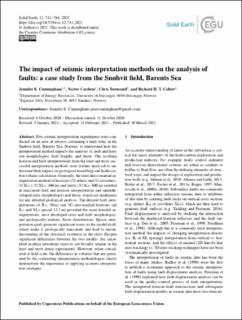| dc.contributor.author | Cunningham, Jennifer Elizabeth | |
| dc.contributor.author | Cardozo, Nestor | |
| dc.contributor.author | Townsend, Christopher | |
| dc.contributor.author | Callow, Richard H. T. | |
| dc.date.accessioned | 2023-02-14T15:19:21Z | |
| dc.date.available | 2023-02-14T15:19:21Z | |
| dc.date.created | 2021-12-08T15:39:36Z | |
| dc.date.issued | 2021 | |
| dc.identifier.citation | Cunningham, J. E., Cardozo, N., Townsend, C., & Callow, R. H. (2021). The impact of seismic interpretation methods on the analysis of faults: a case study from the Snøhvit field, Barents Sea. Solid Earth, 12(3), 741-764. | en_US |
| dc.identifier.issn | 1869-9510 | |
| dc.identifier.uri | https://hdl.handle.net/11250/3050830 | |
| dc.description.abstract | Five seismic interpretation experiments were conducted on an area of interest containing a fault relay in the Snøhvit field, Barents Sea, Norway, to understand how the interpretation method impacts the analysis of fault and horizon morphologies, fault lengths, and throw. The resulting horizon and fault interpretations from the least and most successful interpretation methods were further analysed to understand their impact on geological modelling and hydrocarbon volume calculation. Generally, the least dense manual interpretation method of horizons (32 inlines and 32 crosslines; 32 ILs × 32 XLs, 400 m) and faults (32 ILs, 400 m) resulted in inaccurate fault and horizon interpretations and underdeveloped relay morphologies and throw, which are inadequate for any detailed geological analysis. The densest fault interpretations (4 ILs, 50 m) and 3D auto-tracked horizons (all ILs and XLs spaced 12.5 m) provided the most detailed interpretations, most developed relay and fault morphologies, and geologically realistic throw distributions. Sparse interpretation grids generate significant issues in the model itself, which make it geologically inaccurate and lead to misunderstanding of the structural evolution of the relay. Despite significant differences between the two models, the calculated in-place petroleum reserves are broadly similar in the least and most dense experiments. However, when considered at field scale, the differences in volumes that are generated by the contrasting interpretation methodologies clearly demonstrate the importance of applying accurate interpretation strategies. | en_US |
| dc.language.iso | eng | en_US |
| dc.publisher | Copernicus Publications | en_US |
| dc.rights | Navngivelse 4.0 Internasjonal | * |
| dc.rights.uri | http://creativecommons.org/licenses/by/4.0/deed.no | * |
| dc.title | The impact of seismic interpretation methods on the analysis of faults: a case study from the Snøhvit field, Barents Sea | en_US |
| dc.title.alternative | The impact of seismic interpretation methods on the analysis of faults: a case study from the Snøhvit field, Barents Sea | en_US |
| dc.type | Peer reviewed | en_US |
| dc.type | Journal article | en_US |
| dc.description.version | publishedVersion | en_US |
| dc.rights.holder | The authors | en_US |
| dc.subject.nsi | VDP::Teknologi: 500 | en_US |
| dc.source.pagenumber | 741-764 | en_US |
| dc.source.volume | 12 | en_US |
| dc.source.journal | Solid Earth (SE) | en_US |
| dc.identifier.doi | 10.5194/se-12-741-2021 | |
| dc.identifier.cristin | 1966335 | |
| cristin.ispublished | true | |
| cristin.fulltext | original | |
| cristin.fulltext | original | |
| cristin.qualitycode | 1 | |

